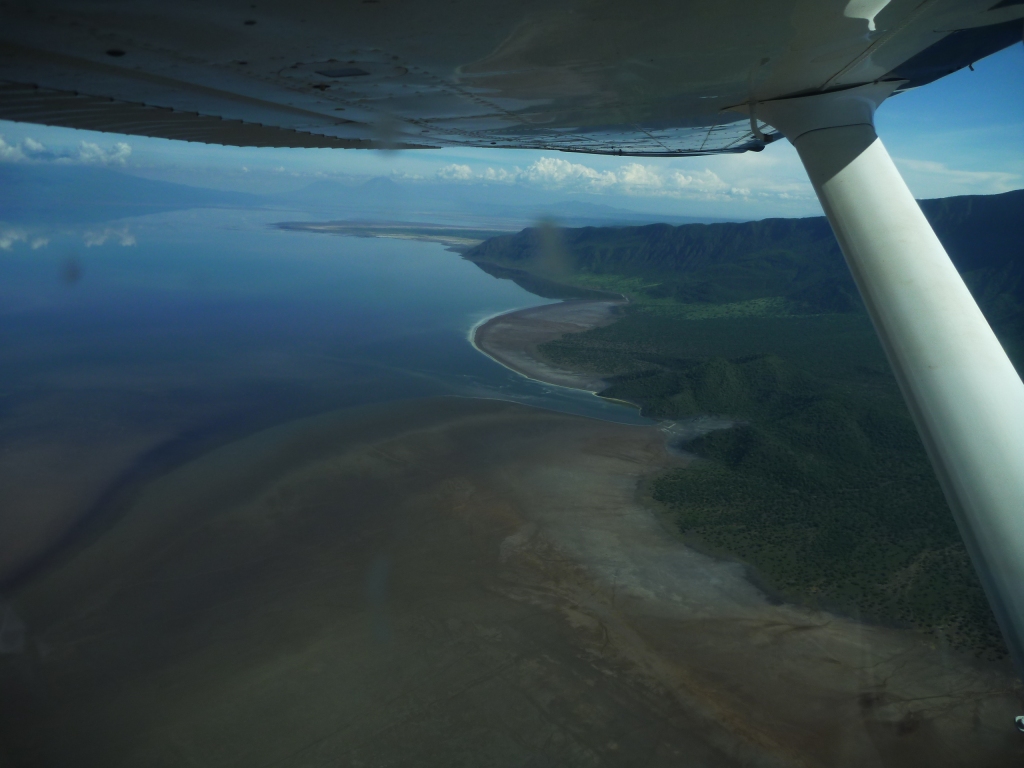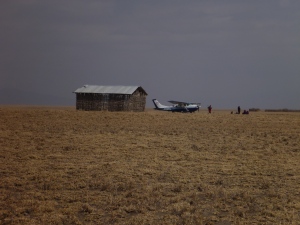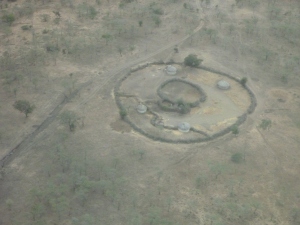It’s a misty morning. Wisps of cloud form halos around the tops of hills and mountains, and fog lies heavy in the deep valleys. The small patches of native forest that remain cling precariously to steep ridges, the last uninhabited areas around Arusha. In sharp contrast to the green hills, the flat land that spreads beyond is a patchwork of brown and yellow farmland. Severe erosion has created deep violent scars in the earth, marking out stark, impassible borders between smallholdings.
As we leave Arusha in the Flying Medical Service’s Cessna 206, the land below us flattens and becomes uniformly brown. The occasional concentric circles of Maasai bomas dot the land: an outer circle made of thorn bushes creates a barrier against passing wildlife, a second thorn circle inside this is used to shelter cows and goats, and several round huts with thatched roofs fill the space between, providing quarters for the various wives and children that would make up a single family unit. I trace the lines in the dust far below with my eyes, and notice a starburst pattern where paths trodden from all directions converge towards the only water source for miles.
A faint shadow of green is blooming beneath the brown of dead grass that has been eaten down to the ground by grazing cattle, who have long since been moved away by their keepers in search of better food. The rains have started recently, and soon the land will be transformed by new growth. Then the nomadic herders will return with their animals to enjoy the fruits of their homeland – but for now the area remains empty and still. We are flying out to isolated villages in the Ngorongoro Highlands to deliver medical attention and vaccinations, but the today’s clinics will undoubtedly be quiet due to the season.

Approaching Lake Natron
The plane flies into a cloud and for a few moments we lose all visual input. The steady drone of the engine lulls us into a dreamlike haze. Mike, the pilot, checks instruments and GPS, the only things that remind us we are still moving forward. When we break through, the gleaming mirror of Lake Natron shimmers in front of us. Clouds and sky blend almost indistinguishably into the still water. We bank left, away from the lake, and the ground rises into dramatic cliffs. Below us, a waterfall bursts out of solid rock walls, crashes down a gorge into a river, and flows down to the lake. Greenery lines the river, but just a few yards out from its banks the land is completely brown again and unmarked by human inhabitants.
As we approach the village where we will carry out the first clinic of the day, bomas and wooden huts start to appear again. Bright blue tarps, donated by an NGO to keep homes dry in the rainy season, decorate the roofs of many huts. They are startlingly incongruous to the rest of the structures: these huts made of earth and grass are normally incredibly camouflaged. I suppose it’s only recently in human history that our homes have become a different color from the natural materials around them.
We fly low over the runway to check for any hazards (like stray animals or rocks), then bank sharply to turn and land. I hold my breath and my stomach tightens as the plane swoops into a steep 180-degree turn – this is my least favorite part. Soon we level out and transition into a relatively smooth landing, though the plane bounces and shudders as we roll over the tufts of grass and small stones that pock the ground. We emerge from our shiny metal tube like visitors from outer space. Men, women and children in traditional dress have gathered and stand observing us; the men lean on their wooden staffs nonchalantly and the women rock crying babies hidden beneath their shawls. Children hide shyly behind their mothers, peering out from behind their skirts.
Around the runway there are several round shelters constructed by piling thorn bushes in a perimeter around an acacia tree, whose branches stretch out to create a ceiling. A thick plume of smoke pours out of one of these shelters, announcing the presence of a recently-lit cooking fire. Our Tanzanian doctor, Babu, jumps out of the plane and strides towards the fire, eager for a fresh cup of tea. Mike and I opt to skip the tea and stand near the plane, waiting for more people to arrive before starting the clinics. We sip strong coffee from a thermos and wrap our windbreakers around us against the chilly breeze.
A solitary woman appears on the horizon, walking slowly towards us. I wonder where she has come from, how many hours she’s walked across the wild land we have just flown over. The concept of covering that much distance on foot in order to see a doctor is hard for me to grasp. But as I think about it, I realize how inconceivable the huge distance we’ve just covered by air would seem to her, and how strange that birds-eye view of her land would be. She approaches and for a moment we seem to stand on either side of a crevasse, each utterly unable to comprehend the world of the other. Yet we smile and exchange greetings, and there is a genuine warmth between us.
Others appear from separate points on the horizon, and we prepare for work. We unpack medicine boxes from the plane and carry them into one of the tree-shelters. Babu and the other doctor, Kitundu, sit behind a table to hear each patient’s complaints. After some examination and consideration, they prescribe a battery of medicines and Mike and I count out the appropriate number of pills. It’s still cold and cloudy, and the wind numbs my fingers as I count out the various brightly-colored tablets – 20 yellow, 30 pink, 14 green… The wizened faces of elderly Maasai men and women stare down at us and at those who recount their ailments to the doctors. Everyone around us is draped in the reds and blues and purples of the thin blankets that they wear like robes, which don’t seem nearly warm enough to keep out the bitter morning air. Their elaborate earrings and bracelets tinkle like wind chimes.
After counting pills for several patients, we notice a gathering group of women standing around nearby with babies, waiting for the vaccination clinic to start. Mike and I excuse ourselves from the doctors and go back to the plane to set up. I pull out the scales and hang them from a hook on the underside of the wing, while mamas muscle their babies into hammock-like sacks that will hook onto the scales to measure the children’s weights. The first little boy, about two months old, gets put on the device, blinking in sleepy confusion as he swings freely in the air. His eyes widen as he sees me, takes in his situation, and desperately flails his hands in search of his mother. I record his weight – 5.5 kilograms – and mama snatches him up just before he can start to wail. Beside me, another child screams as Mike gives injections, an unpleasant surprise for a sleeping infant.
There are only nine kids for this clinic today, so we finish quickly. As I pack up, one of the oldest mothers, or maybe a grandmother, sits down close to me and watches. Obviously wanting to make conversation, she asks me in broken Swahili, “You – Arusha – 8 o’clock morning?” Yes, I reply, I came from Arusha this morning. “Pole sana!” she says: sorry for the long journey. She tells me she’s been to Arusha before; in fact, she mentions the name of the hospital where our doctors work. I ask if she went with this baby, indicating the child strapped to her chest, and she nods. I wonder what kind of medical emergency took them to the city, but we have reached the limit of our language skills and I can’t get any further details. She smiles as she watches me load equipment back into the plane. Her two front teeth stick out almost at a 90-degree angle from her gums. She says goodbye in Maasai and I wish her a safe journey home in Swahili.
The sun finally comes out from behind the clouds and the change in temperature is instantaneous. The cold wind becomes a comfortable breeze. I stand in the sun, warming my hands and face. It looks like the doctors are finishing up their consultations in the hut, and Babu walks toward me with a very young pregnant woman. She looks maybe 15 or 16 years old. He asks me to get some ferrous folate vitamins and anti-malaria medicine for her, a standard prescription to bolster the health of the pregnant women who live so far from medical facilities. I rummage around the plane and produce the little packets for him, and listen as he explains to her in Maasai how she should take them. Next, he orders a tetanus vaccination, so I call Mike over. We look at her health record card – this is her first baby. She looks at the syringe in Mike’s hand, unfazed. Curiously, the older women seem to fear injections much more (is it through past experience? Or do they feel less need than the younger women to prove their courage?) She winces very slightly as she receives the shot in her upper arm, then she walks away without saying anything to us.
We finish loading up our equipment, say goodbye to the village leaders who have come to see us off, and climb back into the plane. The engines start with a sputter and the spinning propellors kick up a cloud of dust that blows behind us. We taxi down the bumpy runway, turn around, and soon we are in the air again. The houses and waving villagers grow smaller and smaller beneath us until they are out of sight, and once again I wonder how they perceive us, how our visit fits into their daily lives, how they reconcile this invasion from a far-away world with their quiet, familiar circles of existence.

A hut and the FMS plane
The second clinic is much the same, with a slightly different landscape and fewer huts around. There are more babies here – around 15 – but it’s still a very slow day compared to some of the other areas where clinics are conducted. Three young women of a similar age seem to have come together with their new babies, who are also almost the same age. It’s obviously the first time that they have been to clinics, because the older women are instructing them on how to put their children into the weighing hammocks and hang them from the scale. They are afraid to let go of their babies and let them dangle freely, which is necessary to get the proper weight. I smile and gently push their hands away, murmuring comforting words that they can’t understand in English and Swahili. It only takes a second to record the weight, then the young mothers can hold their precious cargo close again, comforting the fussy newborns.
Next I have to fill out new health record cards for each of them, a complicated task since we share no common language. An old man comes over and stands next to one of them to help translate from Swahili. I suppose he is her husband. With probably 50 years separating them, I wonder whether she sees her new baby as a yoke, or as the blessing that her culture tells her it is. But this is a perfectly normal arrangement for their society, and maybe it’s not my place to pass judgements. There is a lot of awkward giggling as we stumble through the questions on the form – name of the baby, name of the mother and father, age and gender of the child, etc. Finishing up, I thank the man for his help and go back to the scales to weigh the next baby.
Mike is busy making babies cry. (OK, giving them free life-saving vaccines!) Each time a child wails, raucous laughter erupts from the three older men who are standing around watching. They are the village leaders, here to supervise and assist where needed. I wonder what’s so funny. Maasai men are forbidden to show any expression of pain from the day they perform the rite-of-passage ceremony that makes them officially adults. Perhaps that’s why they find it amusing to see these young boys scream and cry… or maybe they enjoy seeing the expression of an emotion that they are no longer allowed to show? Or maybe it’s just the universal guilty pleasure of laughing at someone else’s pain, that phenomenon that makes YouTube “fail” videos so popular.
The next little girl to be vaccinated sits on her mother’s lap and gives me the most intense stare. She has arresting eyes that give me the impression that a much older being is looking out through them. I return her stare, mesmerized by her fierce expression as she receives her shots with barely a flinch. She doesn’t make a sound and the observers seem to be impressed by her stoicism. Mike says she’s only 18 months according to her record card, but he also thinks she looks much older. Her mother bundles her up and leaves without speaking.
As we finish up and prepare to leave again, the village chairman comes over to chat with me. He is curious about this new person who he’s never seen here before. He speaks Swahili well and asks if I am a doctor at the same hospital where Babu works. I tell him that I’m actually a teacher, and he responds with the admiration given to such noble professions here in Tanzania. He seems to be taking an excessive interest in me, and I quickly tell him that Mike is my husband, but this information doesn’t diminish his warm smile and I realize that it’s just genuine friendliness gleaming in his eyes. He wishes me a happy Christmas and New Year, and I return the wishes in halting Swahili. Using one of my few Maasai words, I say goodbye to the remaining onlookers and get into the plane.
Observing us as we taxi away and prepare to take off, some of the villagers wave and others simply lean on their walking sticks, watching impassively as we depart, heading our separate ways into our almost incomprehensibly different worlds.

A Maasai boma seen from the air



 Posted by oneworldmanycultures
Posted by oneworldmanycultures